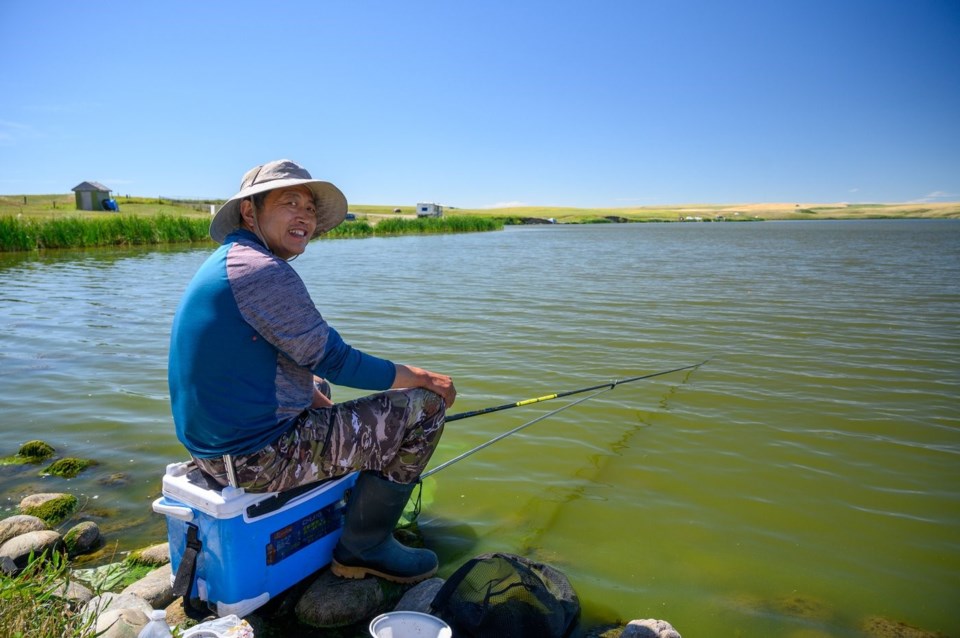A species of carp is spreading throughout southern Alberta’s waterways – and it is up to anglers to stop their spread and, potentially, control their numbers.
The Prussian carp (Carassius gibelio) is a medium-sized fish species related and similar in appearance to goldfish (C. auratus). Native to Siberia, the species has been introduced to and established within waterbodies in Asia, Australia, Europe and, recently, North America.
The first record of Prussian carp in North America was reportedly made in south-central Alberta in 2000. Subsequent fish sampling found the species in a number of nearby rivers and waterbodies, through efforts conducted between 2006 and 2014.
The species was first found to inhabit “open waters” (e.g. a lake) in 2006, when one was collected at West Lake, a waterbody connected to the Western District Irrigation system located just 13 kilometres east of Strathmore. The species was also confirmed to inhabit Serviceberry Creek, the Red Deer River, the Rosebud River (all in 2012) and the Bow River (2013), all of which intersect or border Wheatland County.
As Prussian carp are nearly indistinguishable from goldfish, a University of Calgary research team led by Erick Elgin confirmed these observations using DNA, in an approach similar to that used in crime scene investigations.
The Alberta Conservation Association (ACA) continued to monitor the spread of the species in 2018 and 2019, using a newer technique called environmental DNA (eDNA). Using this approach, water samples were collected at various sites in 15 of Alberta’s river basins, then were analyzed for the presence of the species’ DNA, rather than sampling the species directly. They found evidence of the species in the Bow, Red Deer, South Saskatchewan and Oldman basins.
The species can spread rapidly because they tolerate a wide range of environments, including waterbodies with low oxygen and water quality, eat a variety of food sources and reproduce rapidly, with females spawning up to three times per year.
Prussian carp also use a unique form of reproduction, called gynogenesis, that does not actually involve any males – at least not of the same species. “It’s kind of a clonal form of reproduction; all the fish needs to reproduce is sperm from another species that is similar enough to itself,” explained Britt Schmidt, an ACA fish biologist who led the eDNA monitoring program. “They don’t actually use any of the genetic components of that sperm, it just triggers reproduction in a female Prussian carp.”
Prussian carp can thus establish and proliferate rapidly, then take up space and resources from native species, which may decline as a result, explained Schmidt.
This can have economic impacts. “They can prevent anglers from going out and catching native species. If you’re constantly pulling carp out, it might make fishing somewhere less attractive,” she said.
Also, once in irrigation canals, the species has the potential to clog intakes and other infrastructure.
Once established, Prussian carp are difficult to eradicate. “Trying to get rid of them is very challenging and is pretty much impossible,” said Schmidt.
Even for isolated systems such as some stormwater ponds, the only tried and true method of eradicating Prussian carp is chemical agents, such as Rotenone, said Graham Young, a fish biologist and environmental consultant.
“We’ve tried dewatering and freezing ponds to get rid of them, and we’ve tried electrofishing and seine netting,” he said. “You can control them with those other methods, and possibly angling, but we found that the only way to actually eradicate them is Rotenone.”
But this compound is not specific, meaning they kill anything with external gills, and is therefore not an option for controlling Prussian carp populations in natural waterbodies or those that are connected to larger systems, he said.
So, prevention is key.
Not moving live fish is essential to stopping their spread. Provincial law reflects this – illegal transferring live fish may result in a $100,000 fine, and/or a year in prison. Using live fish as bait is also illegal.
“Catch it, kill it” is the province’s motto when it comes to Prussian carp, meaning that if one is caught, an angler should kill it and take it home to eat or make sure it ends up in the garbage. Simply leaving a live fish on the shore is not good enough, as they can live out-of-water for hours.
Anglers are also encouraged to report sightings of the species, to help track their spread, either by phone (1-855-336-2628) or online (invasivereport.com).
While anglers might not be able to eradicate Prussian carp from an area, they could help control their populations, said Joe Grainger, while fishing for the species at the Severn Dam Reservoir located north of Standard.
“Unfortunately, they’re a little different to catch than trout, pike or anything like that,” he said.
A specialized carp rod can help, explained Hong Lee, who was also trying for the species at the reservoir, albeit more successfully. His rig featured a long rod without a reel supported by a rod holder, and a fixed-length line with a weight, bubble and a split-hook. Lee had already caught eight carp that day.
Prussian carp can be tricky to cook with, as they are “spiny,” featuring numerous small bones. They are most often used to make a soup base, but pan-frying is also an option, explained Lee.
If one develops a taste for Prussian carp and the skill to catch them, they could enjoy them in abundance – there is no take limit for the species.



